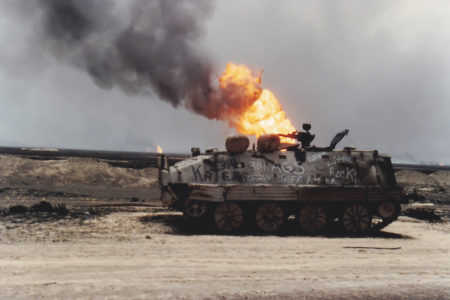
Share On Social!
In August 1990, former President George H.W. Bush began Operation Desert Storm in response to the Iraqi invasion and occupation of Kuwait.
More than 650,000 U.S. military personnel would join the Gulf War over the next year before this Middle Eastern conflict formally ended on July 31, 1991.
Sadly, Gulf War illness continues to affect 30% of those veterans today, decades later.
While there is a limited understanding of this sickness, researchers are making strides to discover how to help affected soldiers, according to Jorge M. Serrador, an associate professor at Rutgers Medical School and a scientist at the New Jersey War Related Illness and Injury Study Center.
“Although it’s been more than 25 years since the conflict, we still do not understand the underlying cause of these symptoms and have yet to develop an effective treatment,” Serrador told Science Daily. “For these veterans, it’s like walking on a balance beam all day.”
This is an issue that could be impacting many of the 20,000 Latino soldiers who took part in Operation Desert Storm.
What is Gulf War Illness?
This condition is impacting a subset of service members who served in a Middle Eastern conflict, but there are a variety of health impacts, according to the Department of Veterans Affairs (VA).
“These veterans have difficulty concentrating, difficulty remembering recent information and trouble finding words when speaking,” Glenn Lin, a professor of neuroscience at Ohio State University and who led a study that tested experimental drugs’ effect on the illness last year, told Ohio State News. “They also often feel down or depressed, irritable, moody, and anxious, and have problems getting to sleep or staying asleep.”

Gulf War illness’ effects can include:
- Fatigue
- Headaches
- Joint pain
- Indigestion
- Insomnia
- Dizziness
- Respiratory disorders
- Memory problems
Experts acknowledge there is a lack of hard evidence pointing to one root cause of the “cluster of medically unexplained chronic symptoms.”
What Do Experts Know?
During their time in active duty, these soldiers experienced some form of contact with numerous toxic chemicals and environmental hazards.
Some researchers, including Dr. Ashok Shetty, a molecular medicine professor at Texas A&M University’s College of Medicine and an associate director of the Institute for Regenerative Medicine, have connected Gulf War illness to these kinds of exposures.
“We knew several of the wartime chemicals in question could enter the brain through a leaky blood-brain barrier, which caused a buildup of a neurotransmitter called acetylcholine,” Shetty said. “The acetylcholine typically excites neurons but can also make neurons sick or even die due to too much excitation, which creates the inflammation.”
Dr. Claudia Miller, an environmental health professor and leader of the Hoffman TILT program at UT Health San Antonio, connects Gulf War illness to Toxicant‐Induced Loss of Tolerance (TILT). 
“With the Gulf War veterans, it doesn’t matter so much which exposure caused their breakdown in tolerance — be it pesticides, smoke from the oil fires or pyridostigmine bromide pills,” Dr. Miller writes. “Those things have long since left these veterans’ bodies. It’s the aftermath of these exposures—the new-onset intolerances to low-level chemical exposures—which appear to be perpetuating their symptoms.”
Miller’s research shows that when veterans with Gulf War illness are introduced to new harmful environmental or chemical exposures, their symptoms worsened.
Gulf War veterans concerned about this illness can visit the VA’s website for more information about:
- The disease itself
- Benefits offered to those impacted
- Gulf War Registry health exam
- Airborne Hazards and Open Burn Pit Registry
Find out more about TILT, and discover if you are experiencing the sickness by taking the QEESI and BREESI assessments — then share that information with your doctor to discuss how to create chemically-safe environments in the home.
TAKE BREESI & QEESI!
Editor’s Note: This article is part of a collaboration between Salud America! and the Hoffman Toxicant-Induced Loss of Tolerance (TILT) program at UT Health- San Antonio. To find out if you are TILTed due to exposure to everyday foods, chemicals, or drugs, take a self-assessment or learn more about TILT.
Explore More:
Chemical & Toxic ExposureBy The Numbers
1
Quick Survey
Can help you find out how chemically sensitive you are



